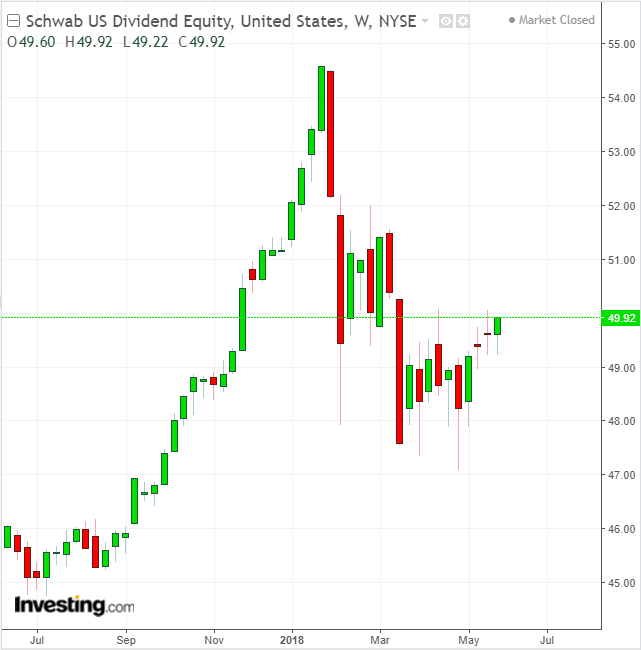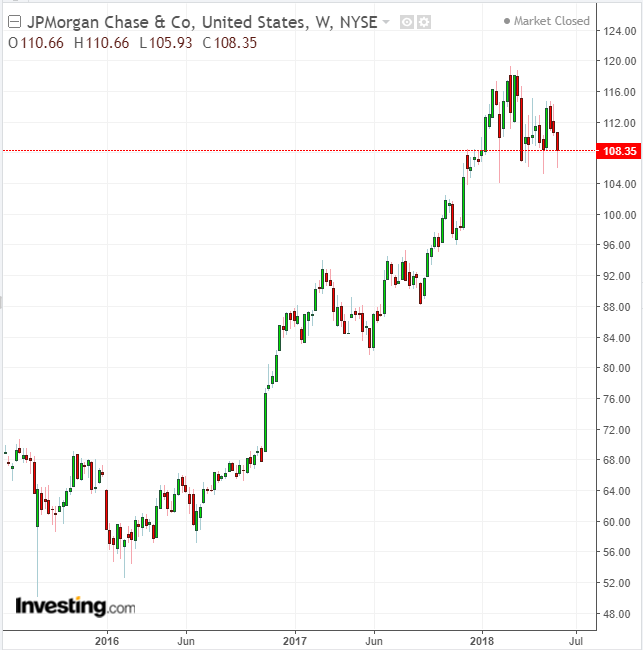It’s no secret that shares of companies that pay dividends underperform when interest rates rise. Investors usually shun dividend stocks as surging bond yields, via fixed ncome Treasuries for example, diminish the appeal of riskier assets such as equities.
Put simply, higher interest rates make dividends less attractive, especially relative to a fixed-income alternative. Once yields rise to a certain level, stock investors become more attracted to low risk bond yields rather than higher volatility stock investments. That scenario can reduce returns from dividend stocks, even when the overall economy and company fundamentals remain strong.
The U.S. central bank is likely to raise rates “soon” if the economy performs as expected, according to the FOMC's minutes of their May meeting. Indeed, markets expect a hike in June, though the outlook for rate increases in the second half of the year is less certain. The U.S. central bank has raised interest rates six times since it began the current hiking cycle in December 2015.
How did that monetary tightening policy affect the performance of dividend stocks in the U.S.?

The Schwab U.S. Dividend Equity Fund (NYSE:SCHD), a dividend-focused, equity exchange traded fund, declined 3.6% so far in 2018, more than double the slide in the benchmark S&P 500 index.
If you’re a long-term investor looking to buy quality dividend stocks to hold, this is not an easy environment for you. The biggest conundrum for dividend investors right now is whether to remain true to their dividend-based investment philosophy and simply let the current interest rate cycle pass.
Morgan Stanley, in a recent research note, provided dividend advocates with a reason to stay the course. They endorsed the importance of dividend-growth stocks, to counter the impact of rising interest rates:
“We don’t recommend investors simply chase the highest dividend yields. We suggest they look for companies that are raising their dividend per share and are likely to keep doing so. That’s an excellent sign of financial health.”
So, if you're able to identify stocks that are both safe and that regularly hike their dividends at a pace that beats inflation, that would still leave more cash in your bank account. Moreover, I think you can still find attractive opportunities that meet these exact criteria in the dividend space. Here are some top dividend growth stocks which we believe offer attractive income opportunities even at a time when rates are headed higher.
2 Tech Giants
Apple (NASDAQ:NASDAQ:AAPL) and Microsoft (NASDAQ:MSFT) are a great combo, providing exposure to new and old technology companies that both deliver steady, positive cash flows along with the strong potential for regular dividend hike payouts—all supported by robust underlying businesses.
If you only look at their dividend yields, less than 2% each right now, you may not find them attractive compared to bond yields. But the main reason to invest in these tech giants is their low dividend payout ratios. These underscore both Apple's and Microsoft's ability to hand out much more cash to investors going forward.

In the case of Apple, the smartphone and personal computer behemoth is returning an additional $100 billion in share buybacks to investors as the company generates mountains of cash from its iPhone sales. In its most recent quarterly earnings report, Apple also increased its quarterly dividend by 16%, to $0.73 a share. With just a 25.5% payout ratio—the percentage of the company's income that goes to pay dividends—there's plenty of runway for this tech giant to grow payouts.

The Microsoft story is a bit different, but no less compelling. The software stalwart has seen its payout ratio fall drastically to 44% from about 70% a year ago on the strength of its earnings, providing additional room for this old-economy tech giant to grow its $1.68 a share annual dividend.
Financials Are Coming Back
Prior to the 2008 financial crisis, the financial sector contributed about 30% to the S&P 500 dividend yield. Post crisis, this metric fell to about 9% as banks retained more cash with which to shore up their balance sheets. Betsy Graseck, an analyst who covers large cap banks for Morgan Stanley, says banks have some $100 billion in excess capital, which could lead to higher payouts in 2018 versus last year.
“We believe that these dynamics make the sector attractive from a dividend-growth perspective, particularly as financials offer a buffer against rising interest rates, given that they can make higher profits as rates rise by charging more for loans.”
In the financial space, we like JPMorgan Chase (NYSE:JPM).

It's the largest commercial bank in the U.S. which not only survived the 2008 financial crisis, but also emerged stronger. Annual distributions have grown to $2.24 a share from $0.8 a share during the depths of the aftermath of the crisis.
As well, higher interest rates, a strong economy, and strong job gains all bode well for banks. Each factor allows these institutions to profit more from lending.
Bottom Line
There's no doubt rising interest rates will keep dividend stocks depressed. But it’s not a good idea to paint every dividend stock with the same brush.
Companies with low payout ratios, earnings momentum and a clear bias toward rewarding investors are still good candidates for your income portfolio. Indeed, they're likely to outperform the broader market when you add up their total return—dividends, capital gains and share buybacks.
